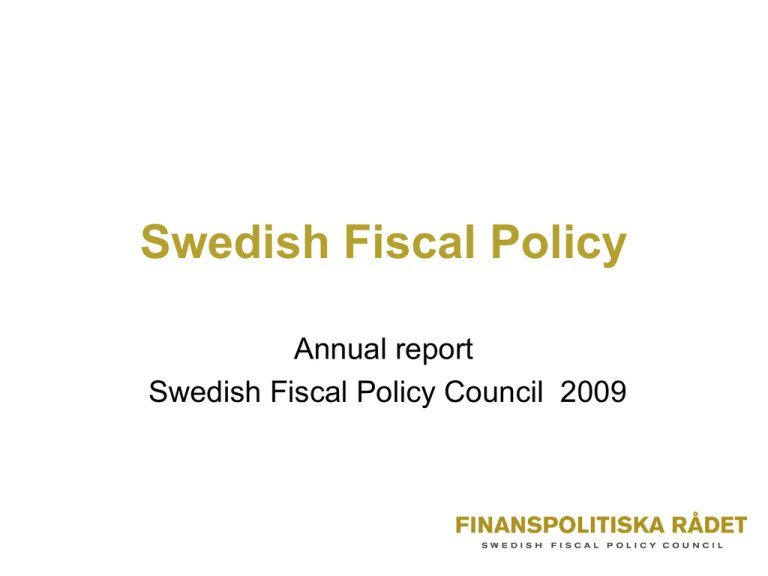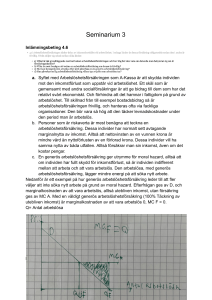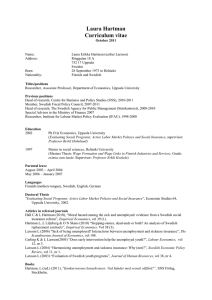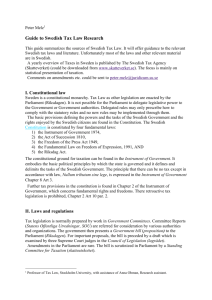Bild 1
advertisement

Swedish Fiscal Policy Annual report Swedish Fiscal Policy Council 2009 Two main questions 1. How well has the government adjusted policy to the economic crisis? 2. How should the economic-policy framework be developed? The government’s measures to handle the financial crisis • Mainly adequate • Good effects of the bank guarantee programme • Legal framework to deal with insolvent banks should have been put in place earlier • Establish a government agency to administer the support for the financial markets - unfortunate double role for the National Debt Office - both business transactions and administration of support programme Financial risks • • • • The spring bill reports the government’s commitments But it is difficult to get an overview Need of analysis of different risk scenarios Such analyses should be developed as soon as possible Need of more fiscal stimulus? • Drastic revisions of the business cycle forecasts: from GDP rise of 1.3 percent to GDP fall of 4,2 percent • Less generous unemployment insurance • Tax cuts in the budget bill were not designed to stabilise the business cycle • The automatic stabilisers been weakened, but only marginally • Risks for the sustainability of fiscal policy • More difficult to stimulate the economy at later stages of the slump. • Households may save more • Long-term interest rates may rise Automatic stabilisers ~ f =f +f * f= ~ f = net lending automatic stabilizers f * = discretionary component ~ ft = α + ε (y t - y t ) Contributions to the budget elasticity Inkomstskatt Sociala avgifter Moms Bolagsskatt Arbetslöshets -försäkring Budgetelasticitet 1998 18,0 12,8 12,0 3,5 12,1 58,4 1999 17,7 13 12,8 3,8 11,1 58,4 2000 17,2 13,1 12,7 4,9 11,3 59,2 2002 16,5 13,3 12,9 2,7 19,3 54,7 2003 16,9 12,6 13,0 2,9 19,0 54,4 2004 16,8 12,3 12,9 4,1 18,3 54,4 2005 16,9 12,2 13,1 5,2 18,0 55,4 2006 16,8 11,9 12,9 5,2 17,2 54,0 2007 17,0 12,0 13,0 5,0 17,3 54,3 2008 17,6 12,2 13,5 4,6 15,4 53,3 2009 17,4 12,2 13,3 4,9 15,4 53,2 Average and marginal tax rates 2003 and 2009 60 50 40 30 20 10 0 200 000 300 000 400 000 Average tax 2003 Marginal tax 2003 500 000 600 000 Average tax 2009 Marginal tax 2009 700 000 Budget elasticity and size of the public sector 0,6 Sverige Danmark Budget elasticity Österrike B elgien Finland Tyskland Ungern Italien Tjeckien No rge P o rtugal Nederländerna Island P o len Grekland Sto rbritannien Luxemburg Kanada Slo vakien Nya Zeeland Spanien 0,5 0,4 Frankrike Japan USA Schweiz A ustralien Irland Ko rea 0,3 0,2 0,3 0,4 0,5 Public expenditure as share of GDP 0,6 0,7 More stimulus desirable • Up to SEK15 bn 2009 (0,5 percent of GDP), SEK30 bn (1 percent of GDP) next year Reasons • Still no structural deficit according to the government’s calculations. • Stronger public finances than in most other countries • Stronger public finances than in the beginning of the economic crisis in the 1990s • Stable fiscal policy framework • Political consensus on strong public finances Luxemburg Australien Nya Zeeland Irland Sydkorea Danmark Slovakien Tjeckien Finland Spanien Storbritannien Sverige Schweiz Nederländerna Polen Österrike USA Kanada Tyskland Portugal Frankrike Ungern Belgien Grekland Italien Japan Gross public sector debt 2007 (percent of GDP) 180 160 140 120 100 80 60 40 20 0 The sustainability of fiscal policy (the S2-indicator) 10 Tjeckien Luxemburg EU-kommissionen Ungern 5 Storbritannien Slovakien Nederländerna Portugal Belgien Frankrike Spanien Tyskland Grekland Italien Österrike Finland Polen 0 Sverige Irland Danmark -5 -5 0 5 OECD 10 15 ∞ Vt 0 ≥ ∑(Gt - Tt ) /(1 + i )t -t 0 t =t 0 +1 ∞ v t 0 ≥ ∑(g t - τ t )β t -t 0 t =t 0 +1 β V v f = = = = (1+γ)/(1+i) = growth adjusted discount factor net financial wealth net financial wealth relative to GDP intertemporal financial net wealth relative to GDP ∞ f = v t0 - ∑(g t =t 0 +1 t - τ t )β t -t0 s = s2-indicator = permanent annual budget improvement that fulfills intertemporal budget constraint exactly sβ 2 n - f = sβ + sβ + ...sβ + ... = 1- β 1- β i -γ s=f =f β 1+ i s > 0 ⇔f < 0 The S2-indicator and intertemporal financial net wealth, percent of GDP S2 Intertemporal finansiell nettoförmögenhet 0,5 -52,5 Högre utträdesålder -0,8 84,0 Högre vårdkostnader 8,2 -861,0 Basscenario Public sector gross and net debt as percent of GDP 80 60 40 20 0 -20 -40 1993 1994 1995 1996 1997 1998 1999 2000 Bruttoskuld 2001 2002 2003 Nettoskuld 2004 2005 2006 2007 2008 Japan Kanada USA Sverige Tyskland Storbritannien Frankrike Danmark Finland Nederländerna April 2007 Norge Belgien Österrike Spanien Kina Australien Italien Portugal Irland Tjeckien Grekland Interest rate on 10-year government bonds April 2009 7 6 5 4 3 2 1 0 Possible additional measures • Higher temporary central government grants to local governments • Subsidies for renovation of municipal housing stock • Avoid that pensioners’ incomes fall - temporary tax rebate? • temporary tax rebate to low-income households in general? • Increase study grants permanently The government expenditure ceiling should not stand in the way • The purpose of the ceiling is to prevent that high tax revenues in good times lead to excessive spending • Deviations should be possible under exceptional circumstances: escape clause • The government has already manipulated the expendidture ceiling - central government grants for 2010 payed out in 2009 • Open and clear escape clause preferable Balanced budgets for local governments • Procyclical behaviour of local governments amplify cyclical fluctuations • Central government grants should compensate for swings in the aggregate tax base of local governments The Swedish business cycle 1995-2008 Korrelation med Dyt Genomsnitt Volatilitet relativt BNPa (%)b Dxt-4 BNP 1,00 11,88 -0,03 1,00 -0,03 procyklisk Konsumtion 0,75 11,26 0,02 0,68 -0,09 procyklisk offentlig 0,26 11,83 0,15 0,16 -0,32 - statlig 0,08 13,54 -0,00 -0,11 -0,24 kontracyklisk kommunal 0,18 12,18 0,18 0,28 -0,23 - Investeringar 0,17 14,69 -0,03 0,55 0,29 procyklisk offentliga 0,03 17,36 0,05 0,08 -0,01 acyklisk statliga 0,01 11,44 0,09 0,15 -0,16 - kommunala 0,01 18,03 -0,03 -0,08 0,22 - Anställda 0,66 11,29 -0,28 0,29 0,59 procyklisk, eftersläpande offentligt 0,23 - 0,17 0,21 0,17 procyklisk statligt 0,04 - -0,01 0,05 -0,07 acyklisk kommunalt 0,19 - 0,20 0,23 0,20 procyklisk Variabel, x D xt D xt+4 Cyklikalitet Unemployment insurance • Benefit reductions will reduce unemployment in the long run - stronger incentives for job search - stronger incentives for wage moderation • But these factors are less important in slumps • Generosity of unemployment insurance should vary with the cycle - such systems exists in the US and Canada • Initial steps: - extend the period with benefits of 80 percent - increase both minimum and maximum benefits (floor and ceiling) • Unemployment insurance should be mandatory and administered by the government • Need for political consensus Strategies for active labour market policy • The government’s initial strategy: reduce persistent high unemployment in the boom • Currently: handle a large inflow into unemployment and prevent long-term unemployment. • Good with more measures directed towards the shortterm unemployed • Good to double the subsidy to start-up jobs Participants in active labour market programmes, yearly averages, percentage of the labour force 6 5 4 3 2 1 0 1980 1985 1990 Exklusive jobbsökaraktiviteter 1995 2000 Inklusive jobbsökaraktiviteter 2005 Accomodation ratio, percentage of the unemployed who participate in labour market programmes 50 45 40 35 30 25 20 15 10 5 0 1980 1985 1990 Exklusive jobbsökaraktiviteter 1995 2000 Inklusive jobbsökaraktiviteter 2005 The ratio between programme participation (including job search activities) and total unemployment, 1980-2008 I konjunkturberoende program (inklusive jobbsökaraktiviteter) 250 000 200 000 150 000 100 000 2006 2007 2008 50 000 0 0 100 000 200 000 300 000 400 000 Total arbetslöshet 500 000 600 000 700 000 The ratio between programme participation (excluding job search activities) and total unemployment, 1980-2008 I konjunkturberoende program (exklusive jobbsökaraktiviteter) 250 000 200 000 150 000 100 000 2006 2007 2008 50 000 0 0 100 000 200 000 300 000 400 000 Total arbetslöshet 500 000 600 000 700 000 Critique of the labour market policy • Too optimistic view on what job search activities can achieve in a deep recession • Volumes in labour market training are too low • Support for education within firms if agreements of working time and pay reductions exist • The expansion of the job- and development guarantee is not a very active policy • Difficult to find meaningful activities Participants in different programmes, percent of the labour force 3 2 1 0 1980 1985 1990 Utbildning 1995 Subventionerat arbete 2000 Praktik Jobbsökaraktivitet 2005 Composition of programmes 100 90 80 70 60 50 40 30 20 10 0 1980 1985 1990 Utbildning 1995 Subventionerat arbete Praktik 2000 Jobbsökaraktivitet 2005 Activities within the job- and development guarantee, percent of participants in different activities at different periods of an unemployment spell Antal kalenderdagar 1-104 105-209 210-419 420- 4 8,5 13,7 17,2 Projekt 0,7 1,1 0,8 0,6 Kartläggning 25 14,6 11,3 6,9 Förstärkt arbetsträning 2,7 5,8 11,8 13,8 Arbetslivsinriktad rehabilitering 0,8 1,4 3,1 3,6 Arbetspraktik 7,3 13,9 18,3 18,4 Start av näringsverksamhet 0,5 1,5 2,2 2,4 69,3 78 76,6 79,2 Utbildning 2,2 4,9 8,6 7,5 Förberedande insatser 2,1 3,3 4,5 4,7 Fördjupad kartläggning/vägledning 4,8 4,5 7,3 9,2 0 0 0 0 24,1 21,8 10,2 3,6 22 878 14 273 12 879 6 747 Arbetsträning Jobbsökaraktivitet med coachning Praktisk kompetensutveckling Ingen registrerad aktivitet Antal individer Public sector accounting • Accounting of the public sector capital stock and total wealth has improved, but only marginally • Unsatisfactory accounting of public investment • Insufficient basis for parliamentary decisions on the level of public investment The fiscal policy framework and the surplus target • Unclear interpretation of the surplus target - five different indicators • Need to motivate the surplus target • Pre-funding or longer working-life to handle the fiscal consequences of an aging population • Surplus and employment targets are mutually dependent • The fiscal and employment frameworks should be integrated • Interdependent decisions on fiscal and employment targets Budget surplus indicators Budgetpropositionen för 2008 Budgetpropositionen Vårpropositionen 2009 för 2009 2007 2008 2009 2010 2008 2009 2010 2011 2009 2010 2011 2012 Net lending 2,9 2,8 3,1 3,6 2,8 1,1 1,6 1,5 -2,7 -3,8 -3,1 -2 Average historical net lending 1,3 1,5 1,7 1,8 1,5 1,5 1,5 1,6 1,1 0,7 0,4 0,2 Average current net lending 2,3 Structural net lending 2,2 2,1 2 -0,5 2,8 3,6 2,8 1,9 2,2 2,7 1,2 1 1,2 1,4 Average historical structural net lending 1,5 1,5 1,5 1,5 Average current structural net lending 1,7 Labour force participation, percent of population 55 50 45 2010 2020 2030 2040 2050 Fraction of life devoted to market work, percent 9,0 8,8 8,6 8,4 8,2 8,0 1930 1940 1950 1960 1970 Automatic indexation of retirement age to life expectancy? • Danish model • But Sweden has no formal retirement age - the lowest age of retirement (61 years) - the age at which social insurance benefits are lost (65 years) - compulsory retirement age (67 years) • Can the surplus target be revised downwards? Estimated age of retirement with indexation to life expectancy Pensionsålder vid samma Förväntad återstående förväntade antal år med pension livslängd vid 65 års som under 1970-talet ålder vid 65 års ålder 1971-1980 15,8 65,0 1981-1985 16,6 65,7 1986-1990 17,1 66,2 1991-1995 17,7 66,8 1996-2000 18,2 67,4 2001-2005 18,7 67,9 2006 19,0 68,3 2007 19,2 68,4 2008 19,3 68,5 2009 19,4 68,5 2010 19,5 68,6 2015 20,0 69,1 2020 20,4 69,5 Pensionsålder vid samma förväntade kvot mellan pensionsålder och livslängd som under 1970-talet vid 65 års ålder 65,0 65,6 66,0 66,4 66,9 67,3 67,7 67,7 67,8 67,8 67,9 68,3 68,6 Labour force participation at older ages 2008, percent 100 90 80 70 60 Möjlighet att ta ut pension från 61 år. 50 40 Arbetsgivare har rätt att avskeda personer över 67 år. 65 år var referensålder i det gamla pensionssystemet. 30 20 10 0 50 år 55 år 60 år 65 år 70 år Earlier entry • Stronger incentives to begin and finish collage studies earlier - higher study grants - lower maximum labour income - more generous study grants for younger than for older students Average working and study hours per week for employed students 22 21 20 19 18 17 2005 2006 Arbetade timmar 2007 Studietimmar 2008 Study grants in percent of blue-collar and whitecollar compensation 50 45 40 35 30 25 20 15 10 5 0 1970 1975 1980 1985 Totalbelopp relativt arbetare 1990 1995 Totalbelopp relativt tjänstemän 2000 2005





